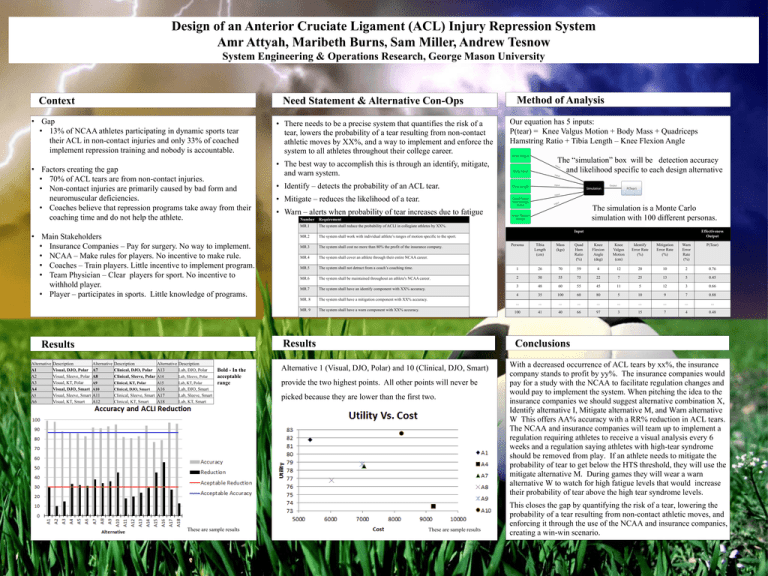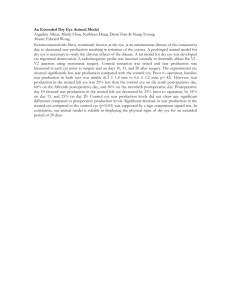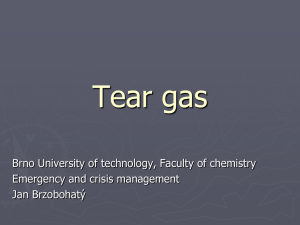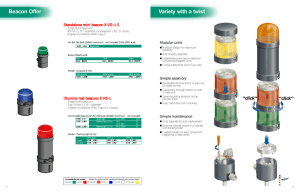Design of an Anterior Cruciate Ligament (ACL) Injury Repression System
advertisement

Design of an Anterior Cruciate Ligament (ACL) Injury Repression System Amr Attyah, Maribeth Burns, Sam Miller, Andrew Tesnow System Engineering & Operations Research, George Mason University Context Need Statement & Alternative Con-Ops • Gap • 13% of NCAA athletes participating in dynamic sports tear their ACL in non-contact injuries and only 33% of coached implement repression training and nobody is accountable. • Factors creating the gap • 70% of ACL tears are from non-contact injuries. • Non-contact injuries are primarily caused by bad form and neuromuscular deficiencies. • Coaches believe that repression programs take away from their coaching time and do not help the athlete. • Main Stakeholders • Insurance Companies – Pay for surgery. No way to implement. • NCAA – Make rules for players. No incentive to make rule. • Coaches – Train players. Little incentive to implement program. • Team Physician – Clear players for sport. No incentive to withhold player. • Player – participates in sports. Little knowledge of programs. • There needs to be a precise system that quantifies the risk of a tear, lowers the probability of a tear resulting from non-contact athletic moves by XX%, and a way to implement and enforce the system to all athletes throughout their college career. Alternative A1 A2 A3 A4 A5 A6 Description Visual, DJO, Polar Visual, Sleeve, Polar Visual, KT, Polar Visual, DJO, Smart Visual, Sleeve, Smart Visual, KT, Smart A9 Clinical, KT, Polar A10 Clinical, DJO, Smart A11 A12 A15 A16 Clinical, Sleeve, Smart A17 Clinical, KT, Smart A18 Lab, KT, Polar Bold - In the acceptable range Lab, DJO, Smart Lab, Sleeve, Smart Lab, KT, Smart These are sample results The “simulation” box will be detection accuracy and likelihood specific to each design alternative • Identify – detects the probability of an ACL tear. • Mitigate – reduces the likelihood of a tear. The simulation is a Monte Carlo simulation with 100 different personas. • Warn – alerts when probability of tear increases due to fatigue Number Requirement MR.1 The system shall reduce the probability of ACLI in collegiate athletes by XX%. Input MR.2 The system shall work with individual athlete’s ranges of motion specific to the sport. MR.3 The system shall cost no more than 80% the profit of the insurance company. MR.4 The system shall cover an athlete through their entire NCAA career. MR.5 Effectiveness Output Persona Tibia Length (cm) Mass (kgs) Quad Ham Ratio (%) Knee Flexion Angle (deg) Knee Valgus Motion (cm) Identify Error Rate (%) Mitigation Error Rate (%) Warn Error Rate (%) P(Tear) The system shall not detract from a coach’s coaching time. 1 26 70 59 4 12 20 10 2 0.76 MR.6 The system shall be maintained throughout an athlete's NCAA career. 2 50 55 75 22 7 25 13 5 0.45 MR.7 The system shall have an identify component with XX% accuracy. 3 48 60 55 45 11 5 12 3 0.66 4 35 100 60 80 5 10 9 7 0.88 ... ... ... ... ... ... ... ... ... ... 100 41 40 66 97 3 15 7 4 0.48 MR. 8 The system shall have a mitigation component with XX% accuracy. The system shall have a warn component with XX% accuracy. Conclusions Results Alternative Description Alternative Description A7 Clinical, DJO, Polar A13 Lab, DJO, Polar A8 Clinical, Sleeve, Polar A14 Lab, Sleeve, Polar Our equation has 5 inputs: P(tear) = Knee Valgus Motion + Body Mass + Quadriceps Hamstring Ratio + Tibia Length – Knee Flexion Angle • The best way to accomplish this is through an identify, mitigate, and warn system. MR. 9 Results Method of Analysis Alternative 1 (Visual, DJO, Polar) and 10 (Clinical, DJO, Smart) provide the two highest points. All other points will never be picked because they are lower than the first two. These are sample results With a decreased occurrence of ACL tears by xx%, the insurance company stands to profit by yy%. The insurance companies would pay for a study with the NCAA to facilitate regulation changes and would pay to implement the system. When pitching the idea to the insurance companies we should suggest alternative combination X, Identify alternative I, Mitigate alternative M, and Warn alternative W This offers AA% accuracy with a RR% reduction in ACL tears. The NCAA and insurance companies will team up to implement a regulation requiring athletes to receive a visual analysis every 6 weeks and a regulation saying athletes with high-tear syndrome should be removed from play. If an athlete needs to mitigate the probability of tear to get below the HTS threshold, they will use the mitigate alternative M. During games they will wear a warn alternative W to watch for high fatigue levels that would increase their probability of tear above the high tear syndrome levels. This closes the gap by quantifying the risk of a tear, lowering the probability of a tear resulting from non-contact athletic moves, and enforcing it through the use of the NCAA and insurance companies, creating a win-win scenario.



